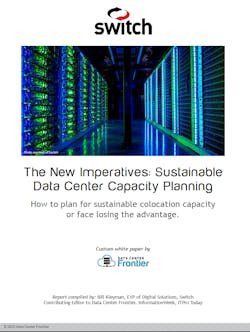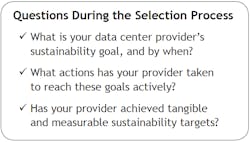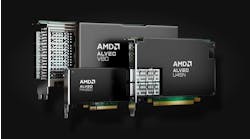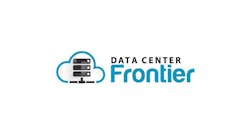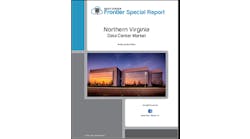The Sustainable Data Center Evaluation Checklist, Part 1
Last week we continued our article series on the new imperatives driving sustainable data center capacity planning. This week we'll outline the first evaluation criteria on the sustainable data center checklist.
The journey towards true, measurable sustainability requires a partner who can guide an enterprise organization towards greener goals. However, not every colocation partner is the same, and not every partner can deliver the sustainable, dense, resilient, and efficient solutions that many organizations require.
And so, we come to our third imperative: How to plan for sustainable colocation capacity or face losing the advantage.
The evaluation criteria below aim to help you create an infrastructure that meets the needs of today’s market imperatives. Also, the following section explores how to create a digital infrastructure that’s sustainable, dense, and ready for a connected tomorrow.
How To Evaluate a Green Data Center Provider to Ensure Capacity and Improve Go-To-Market Strategies
Exploring our third imperative will give you a clearer picture of where you exist with your business and technology needs.
First, let’s ask a few critical questions: Where does your data center stand in the race for a sustainable future? What about optimal capacity and density planning? Are you achieving the go-to-market speeds you need for your business to succeed in a connected world?
It is crucial to take the next step to evaluate whether your data center is actively working towards sustainability initiatives or if they are simply a lofty vision.
When evaluating a sustainable data center built for capacity and density, it is essential to understand where your provider stands. Most companies have established a sustainability mission to reach zero carbon emissions by a particular year, and it is positive that companies have taken strides in setting targets. Still, it is crucial to take the next step to evaluate whether your data center is actively working towards these sustainability initiatives or if they are simply a lofty vision. That said, it’s essential to understand and answer these questions during your selection process.
To understand and align with the third critical imperative, let’s explore the evaluation criteria that should be considered when selecting a green data center. And one that can support growing density and capacity needs. Specifically, we’ll focus on the following:
▶ Power: Density, sustainability, and capacity
▶ Water: Innovation around sustainable, effluent water solutions
▶ ESG Leadership: Meeting and overcoming imperative requirements by leading corporate initiatives
Evaluation Criteria #1: Power — Aim for 100% Renewable Energy
Many colocation providers are powered by 100% renewable energy through carbon credit assistance, meaning they purchase renewable energy credits (RECs). Companies purchase and retire several RECs annually, equal to their total power consumption, to become 100% renewable. However, few companies can buy green energy directly from the source and invest capital into developing new, local renewable energy sources.
Let’s explore a few key questions to ask.
Question: To call themselves 100% renewable, does your data center provider have a dedicated renewable energy resource or do they solely rely on purchasing renewable energy credits from their local utility provider?
There are a few ways to source green energy. The two main methods are to locally source power from in-market sources and the other is to buy Renewable Energy Certificates (RECs). According to Wikipedia, a renewable energy credit (REC) is a certificate corresponding to the environmental attributes of energy produced from renewable sources such as wind or solar. While RECs are not a measure of power, each REC represents one-megawatt hour (MWh) of renewable generated energy.
Those organizations looking to offset their carbon emissions can purchase RECs and report that they source their energy from green sources. However, as a market-based instrument, RECs are an accounting item that can be sold for profit. It’s important to note that RECs are not always purchased in-market and can come from out-of-state energy sources.
When looking for a colocation partner, understand their power sourcing solution and how they are differentiated from other data centers. For example, exascale data centers like Switch exited the local power utility in Nevada. By leaving the local power and utility commission, Switch can shop around on the open market for less expensive green power.
These savings are then passed to the customer, who can take advantage of the lower costs and report their use of green energy.
Although we’ll discuss this in Question #3 on ESG, this energy purchasing solution directly impacts a customer’s corporate ESG goals. Sustainability certificates can be transferred to the customer to reflect on ESG reports.
Question: Does your data center have a dedicated new, local, renewable energy resource such as solar, wind, geothermal, or other green energy projects?
Emerging energy projects have been fascinating to follow. Leaders in the energy development space are actively looking at ways to create greener energy sources to support critical infrastructure. For example, Switch announced Rob Roy’s Gigawatt Nevada, a massive solar energy and battery storage project. This development is one of the technology industry’s largest solar footprint and battery storage projects. Upon completion, it will reach 1 Gigawatt of solar power across Nevada and over 800 MW hours of battery storage leveraging Tesla Megapack technologies.
Partners like Switch have invested in developing new, local renewable energy sources for their dedicated use, and this is important when evaluating partners who can deliver on green energy promises.
Question: What specific technologies does your provider use for energy efficiency?
Part of the challenge with legacy enterprise data centers is their inefficiency. Outside of resiliency challenges, legacy infrastructure is also much less sustainable. In many situations, there isn’t enough airflow control, poor heat isolation, and improper infrastructure containment.
When exploring data center and colocation partners, ensure they have the right technologies to help enterprises and clients be resilient and sustainable.
Leaders in the colocation market persistently aim to improve sustainability measures and ensure that the data and infrastructure operate as efficiently as possible. Hot-aisle containment can achieve a lower PUE and a healthier data center.
An advanced hot-aisle containment design can more than double your data center’s cooling capacity by intelligently isolating the hot exhaust air emitted from your racks.
But what is it, and how does it work?
Hot-Aisle Containment
Hot-aisle containment solutions leverage a physical barrier to guide hot exhaust air toward a designated A.C. return. New patented designs leverage the laws of physics, allowing the natural occurrence of hot air to rise. From there, the hot air is directed, in a chimney setting, into an A.C. return. There are several benefits to using a hot-aisle system. First, it will increase your cooling capacity and allow you to deploy more dense solutions. An advanced hot-aisle containment design can more than double your data center’s cooling capacity by intelligently isolating the hot exhaust air emitted from your racks.
Second, hot-aisle containment will help you become more efficient and reduce energy consumption.
Here’s the particular part: this containment methodology also ensures the greatest levels of density in the industry, supporting up to 55kw per rack. So, not only are you building around sustainable solutions, but you’re also ensuring density and proper capacity planning.
It’s essential to look for configurations that provide complete hot and cold aisle segregation, significantly improving Power Usage Effectiveness (PUE). These containment technologies are the difference-maker in helping organizations realize true performance and efficiency.
Question: Has your data center provider achieved ZERO carbon emissions?
According to the EPA, carbon emissions are responsible for more than 80% of overall greenhouse gas (GHG) emissions. To remain sustainable, enterprises must monitor and report their CO2 emissions, which is the crucial first step in reducing them. To help define a company’s carbon footprint, greenhouse gas emissions are generally categorized into three groups, or Scopes, under the Greenhouse Gas (GHG) Protocol. There are three Scopes to consider:
▶ Scope 1. This measure covers direct emissions from owned or controlled sources.
▶ Scope 2. This measure covers indirect emissions from the generation of purchased electricity, steam, heating, and cooling the reporting company consumes.
▶ Scope 3. This measure includes all other indirect emissions in a company’s value chain.
In selecting a partner, it’s important to challenge them around their emissions strategy and ensure that it’s not just a long-term goal and that their data is verified. For example, partners like Switch have already achieved ZERO Scope 1 and Scope 2 carbon emissions. See the charts below.
Again, as part of your evaluation criteria, be sure to look for partners who are actively tracking toward net zero.
Question: Can you take advantage of your data center provider’s renewable energy benefits to help you achieve your corporate sustainability goals?
Working with your colocation partner must align with your sustainability goals. We’ll cover this in Evaluation Criteria #3; however, ESG scores are crucial. Enterprise leaders transitioning to the colocation data center space must showcase their ESG efforts. As part of this, leadership will ask your partners and suppliers for their ESG data to ensure that your company works with environmentally responsible vendors to help offset your carbon footprint.
This helps clients meet their corporate sustainability goals and reduce the carbon emissions of their overall footprint.
Download the entire special report, The New Imperatives: Sustainable Data Center Capacity Planning, featuring Switch, to learn more. In our next article, we'll outline evaluation criteria #2 and #3. Catch up on the previous articles here and here.


